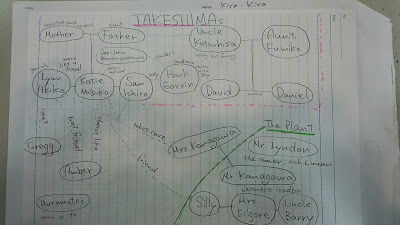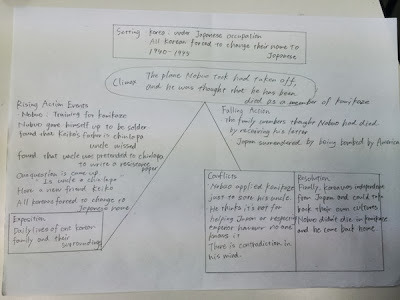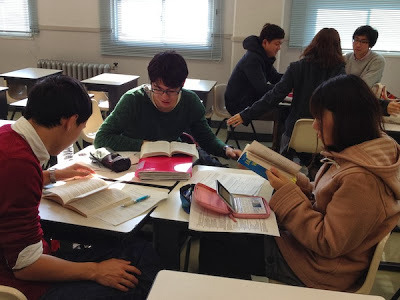COETAIL: Enhancing Literature Circles
I have been happily teaching with literature circles for many years, in part thanks to the efforts of a former university colleague. In a Japanese university EFL setting, literature circles provide a helpful structure to enable even shy and hesitant students to participate with confidence in group discussions. I have adapted the basic principles of literature circles to develop my own collection of literature circle guides for use with authentic literature texts in my university courses--Poetry Circles, Short Story Circles and Literature Circles for Novels.
I teach in a traditional environment in which students have limited access to technology during class. Although many students now have smart phones, students rarely bring a laptop or iPad to class. Wifi is available in classrooms but often impossibly slow and generally inaccessible by computer--though easier to access with smart phones. Occasionally I can teach in a language lab with computer access for all students, but most of my classes are taught in standard classrooms with many desks, a blackboard, and a single computer and projector with a LAN connection.
Given this environment, my literature circles have rarely integrated technology.
But I was intrigued to read Literature Circles Part 1 and Literature Circles Part 2 on the Langwitches blog about an innovative way in which one humanities teacher is integrating technology into grade 6 literature circles discussions. This teacher had the students videotaping their own literature circles discussion, uploading the video, blogging about the process, then digitally analyzing and annotating (or annotexting) the video, and writing a self-reflection blog post.
I'd love to try a similar approach with my university students. If only I had a 1:1 classroom environment in which all students had equal access to technology tools, was my first thought. But actually, now with so many smart phones in university classrooms in Japan, it might be possible to ask students to video record their discussions and analyze and edit those recordings to add another layer of learning.
This semester my Literature Circles for Novels course was disrupted by my sudden relocation to the U.S. for a family health emergency. I am now monitoring student progress from afar. Recently I had my students take photos of the character maps and plot diagrams created during class and share those with me digitally which enabled me to view evidence of their class work without needing a hard copy sent to me. In the future, when teaching face-to-face again, I'd like to take this a step further and have the students upload photos and other evidence of their literary discussions to a blog.
 character map of Kira-Kira by Cynthia Kadohata
character map of Kira-Kira by Cynthia Kadohata
 character map for Feathers by Jacqueline Woodson
character map for Feathers by Jacqueline Woodson
 Plot diagram for When My Name Was Keoko by Linda Sue ParkStudents will soon be sharing their novel reflections with me digitally, and after the New Year break, during the flash fiction unit, they will be sharing an original flash fiction story with me digitally.
Plot diagram for When My Name Was Keoko by Linda Sue ParkStudents will soon be sharing their novel reflections with me digitally, and after the New Year break, during the flash fiction unit, they will be sharing an original flash fiction story with me digitally.
Otherwise, thanks to a substitute instructor, the literature circles for novels have been carried out with little technology. Literature circles are quite magical. Groups of non-native English speakers taking full control of discussions of books they selected themselves and actively analyzing, questioning, interpreting and critiquing is wonderful to witness. The Japanese professor covering my classes witnessed this literature circle magic and commented, "It was inspiring to learn from your methodology. I have to learn from you how you have successfully inspired the students to participate in the class so actively."
 group literature circle discussionsIf it's not broke, why fix it, I've wondered with literature circles. But now I think that enhancing literature circles is my aim--by adding a blogging component to enable sharing photographic evidence of work and analysis of a video recording to help student measure and improve their literary discussion skills.
group literature circle discussionsIf it's not broke, why fix it, I've wondered with literature circles. But now I think that enhancing literature circles is my aim--by adding a blogging component to enable sharing photographic evidence of work and analysis of a video recording to help student measure and improve their literary discussion skills.
I teach in a traditional environment in which students have limited access to technology during class. Although many students now have smart phones, students rarely bring a laptop or iPad to class. Wifi is available in classrooms but often impossibly slow and generally inaccessible by computer--though easier to access with smart phones. Occasionally I can teach in a language lab with computer access for all students, but most of my classes are taught in standard classrooms with many desks, a blackboard, and a single computer and projector with a LAN connection.
Given this environment, my literature circles have rarely integrated technology.
But I was intrigued to read Literature Circles Part 1 and Literature Circles Part 2 on the Langwitches blog about an innovative way in which one humanities teacher is integrating technology into grade 6 literature circles discussions. This teacher had the students videotaping their own literature circles discussion, uploading the video, blogging about the process, then digitally analyzing and annotating (or annotexting) the video, and writing a self-reflection blog post.
I'd love to try a similar approach with my university students. If only I had a 1:1 classroom environment in which all students had equal access to technology tools, was my first thought. But actually, now with so many smart phones in university classrooms in Japan, it might be possible to ask students to video record their discussions and analyze and edit those recordings to add another layer of learning.
This semester my Literature Circles for Novels course was disrupted by my sudden relocation to the U.S. for a family health emergency. I am now monitoring student progress from afar. Recently I had my students take photos of the character maps and plot diagrams created during class and share those with me digitally which enabled me to view evidence of their class work without needing a hard copy sent to me. In the future, when teaching face-to-face again, I'd like to take this a step further and have the students upload photos and other evidence of their literary discussions to a blog.
 character map of Kira-Kira by Cynthia Kadohata
character map of Kira-Kira by Cynthia Kadohata
 character map for Feathers by Jacqueline Woodson
character map for Feathers by Jacqueline Woodson
 Plot diagram for When My Name Was Keoko by Linda Sue ParkStudents will soon be sharing their novel reflections with me digitally, and after the New Year break, during the flash fiction unit, they will be sharing an original flash fiction story with me digitally.
Plot diagram for When My Name Was Keoko by Linda Sue ParkStudents will soon be sharing their novel reflections with me digitally, and after the New Year break, during the flash fiction unit, they will be sharing an original flash fiction story with me digitally. Otherwise, thanks to a substitute instructor, the literature circles for novels have been carried out with little technology. Literature circles are quite magical. Groups of non-native English speakers taking full control of discussions of books they selected themselves and actively analyzing, questioning, interpreting and critiquing is wonderful to witness. The Japanese professor covering my classes witnessed this literature circle magic and commented, "It was inspiring to learn from your methodology. I have to learn from you how you have successfully inspired the students to participate in the class so actively."
 group literature circle discussionsIf it's not broke, why fix it, I've wondered with literature circles. But now I think that enhancing literature circles is my aim--by adding a blogging component to enable sharing photographic evidence of work and analysis of a video recording to help student measure and improve their literary discussion skills.
group literature circle discussionsIf it's not broke, why fix it, I've wondered with literature circles. But now I think that enhancing literature circles is my aim--by adding a blogging component to enable sharing photographic evidence of work and analysis of a video recording to help student measure and improve their literary discussion skills.
Published on December 17, 2013 11:17
No comments have been added yet.



